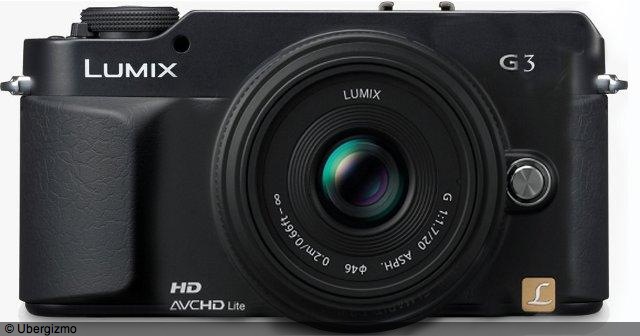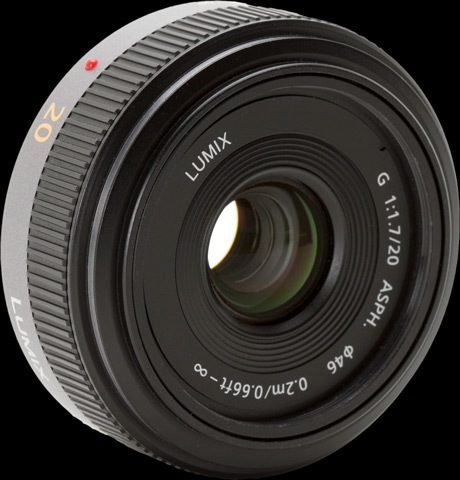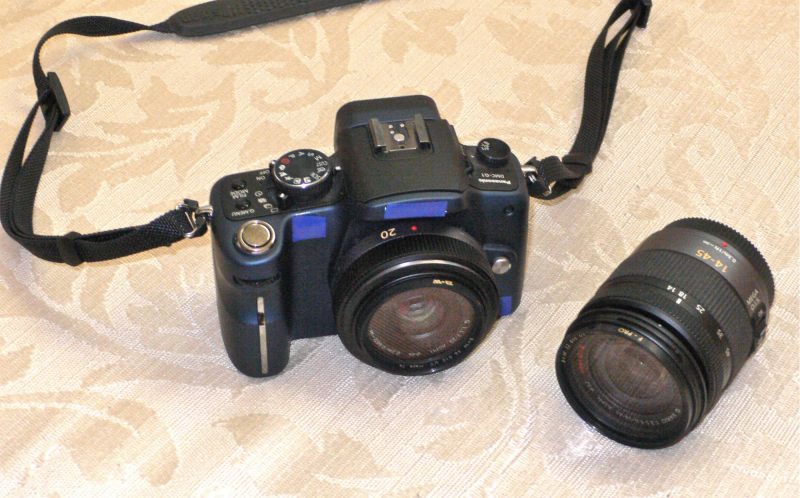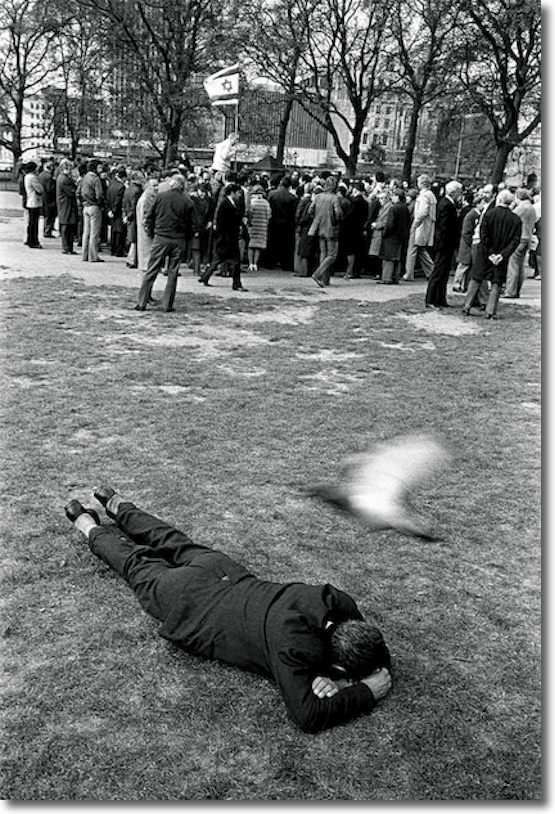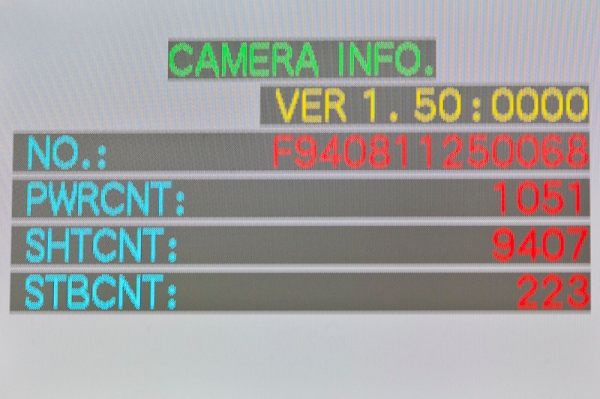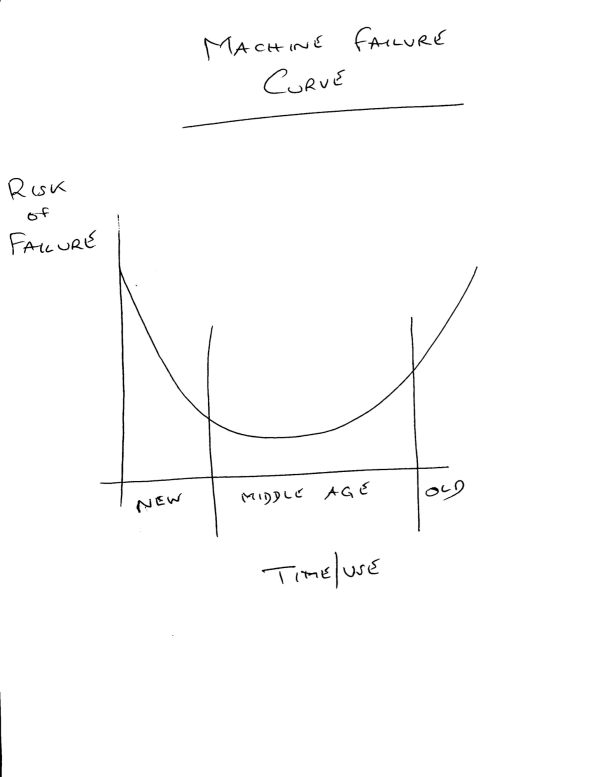A massive disappointment.
I captioned Part I of this review with the words “State of the art”. I have had to go back and revise that to read “State of the art?”. There are several issues with my sample of the 20mm Panny and one is so fundamentally beyond correction that I can only say I am massively disappointed.
No, this is not an April Fool’s Day joke.
The variables not at issue here are the camera body, the technique or the subject matter. All are the same. I took the lens for a spin on the Panny G1, on which I now have over 10,000 exposures. I used the same settings as usual, though I mostly snapped at ISO100 rather than ISO320 to allow the use of a larger aperture in my preferred aperture-priority mode. The lens is f/1.7 fully open and I want to see how that works. I mostly used f/1.7 to f/2.8 and even at ISO100 I was over-exposing in the bright sun that favored my street excursion to San Francisco. That’s frustrating, but hardly the fault of the lens.
Some tests had disclosed that the 20mm is natively quite a bit sharper than my other three lenses for the G1 – the 9-18mm Olympus MFT, the Panny kit lens and the Panny 45-200 zoom. While those all need a sharpening setting of 100 in Lightroom on import to get the image just so, the 20mm only needs 55 for like results. So I set up an import preset with that sharpness setting and imported the snaps taken yesterday.
I’m using the lens with a stock B+W UV filter for protection and no lens hood. I have yet to see one scintilla of evidence that a hood makes any difference with modern multi-coated lenses and refuse to be bamboozled by purported ‘experts’ in the matter. The filter is not multi-coated and, in fairness, presents a far larger glass surface to the world than the front element of the 20mm which is minuscule by comparison.
I mention this because, on importing the pictures into LR3, the following were immediately obvious:
- Flare is everywhere, even in modestly bright into-the-sun pictures. With the possible exception of a 1950 50mm Leitz f/1.5 Summarit with primitive coatings which I used when the dinosaurs still walked the earth, I have never used a lens which flares more. Not even close. A veil over the whole picture, and light spots everywhere. A catastrophe. See also ‘Flare update’ below.
- The lens is disappointingly low in contrast. I have to increase LR3’s Contrast slider to 50 from the default 25 to equal the kit zoom.
- All my pictures are one stop over exposed except for those taken indoors in very low light. Those tend to under-exposure of 1/2 stop.
- The orientation sensor does not work. All vertical snaps (40% of my total) have to be manually rotated in LR3 after import. What? I can forgive Oly this fault in their excellent 9-18 ultra-wide MFT zoom as their lens was not designed for Panny bodies, but a Panny lens on the Panny G1? Inexcusable and a real time waster at the processing stage. Not one single review I have read has mentioned this. Does any of these reviewers actually take and process photographs?
- But, worst of all, for someone who needs fast autofocus for his preferred subject matter, fully 30% (yes, 30%) of my pictures showed that I had depressed the shutter button before the lens had established proper focus and the result was garbage. This really got my goat as there was some great stuff lost forever. I mentioned yesterday that the lens takes twice as long to focus as the kit lens and it seems that the difference crosses my critical point of need. My focus failure rate with the kit lens? Just 3%. Max. Why not set the camera to only allow shutter release when focus is established? That’s about as rational as insisting the US Government manages your retirement monies. Have you seen the returns on Social Security? Please. The problem is that the 20mm defaults to infinity focus after every snap so it has just too much work to do with its slow focus motor for what I do – meaning a typical subject distance of 5-7 feet.
Definition? The lens just sparkles when it isn’t flaring or getting the focus and exposure wrong. No issues there. It’s as sharp and aberration-free, after Panasonic does its in-camera magic, as anything I have used. And that’s all the good news I have to report.
So what are my exit strategies?
Well, maybe I could discard the UV filter and the lens would stop catching flare rays. Or I could get a multi-coated variant. OK. Happy to learn I’m at fault here.
I suppose I could set the camera to underexpose by one stop when the 20mm is fitted but, honestly, it’s one more thing to remember for a guy who is happy just to recall his name in the morning. Contrast? More of the same. Bottom line is that every time you change lenses you are going to screw up and with the Panny’s smallish sensor, proper exposure and contrast are critical if you want to make large prints. I make a lot of those.
The need to turn every vertical image 90 degrees in LR3 does not make me happy but at least it has nothing to do with image quality and I’m prepared to live with that.
But the one thing I do not think has anything to do with sample variation, which cannot be excused with that old chestnut beloved of owners of British cars – “I got a bad one” – is the focus speed. It does not cut it for street snaps. Not even close.
The 20mm is going back to B&H today, where it can make a less demanding user happy. I am so not looking forward to explaining the above to the good people at B&H.
Fuji had better make more X100s really soon. I remain on Amazon’s waiting list, for what that is worth.
I include below some snaps I like from yesterday’s foray and remain bitterly dismayed that so many good images are forever lost. I mean, I was having a really good day, seeing fast, clearly and on point. The Panny 14-45mm kit lens, crappy feeling zoom ring and all, has it all over the Panny 20mm. It just shines by comparison. I can always blur backgrounds using Photoshop CS5. Had you told me that all in one week I would be praising Photoshop and simultaneously trashing Panasonic, I would have pointed you to the local shrink, and I would have been wrong.
The last time I felt this disappointed was when a date told me she didn’t like opera …. with the same result. I dumped her. And like Panny’s 20mm she was lovely to behold. Life is too short for women with poor taste …. and bad lenses.
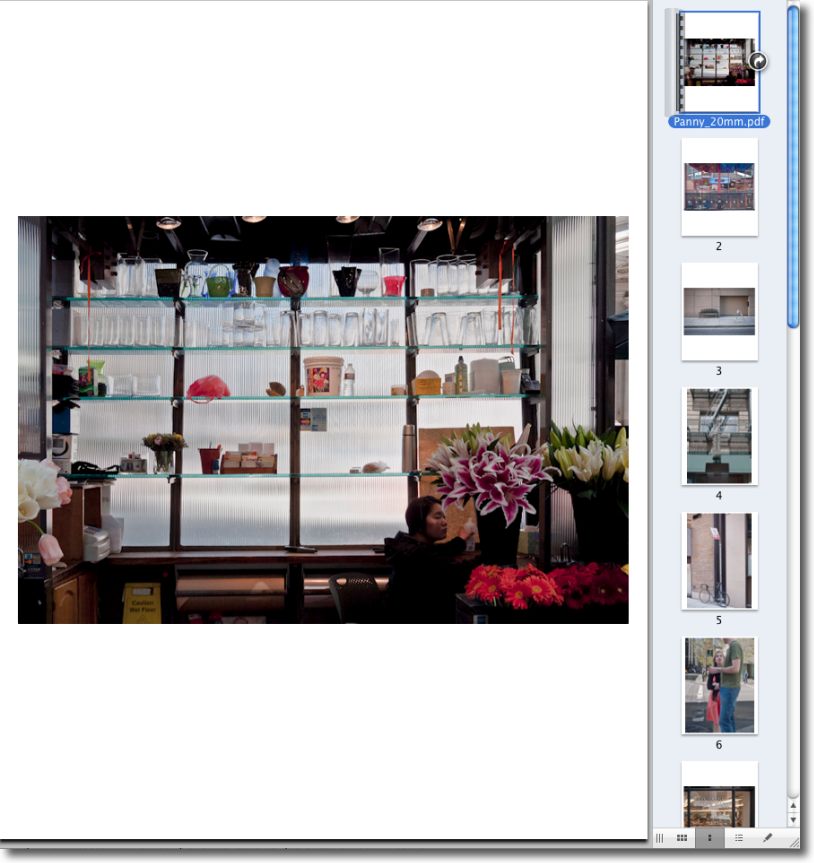
Click the picture to view the PDF.
Flare update: I tried the lens into the sun with and without the filter, just before returning it. No difference – meaning it flares just horribly. There is clearly something very wrong with this aspect of the design of the Panny 20mm. As another test, I compared two screens of unprocessed RAW imports in LR3, the one taken on the 14-45mm kit lens, the other with the 20mm. The flatness and poor native contrast of those taken on the 20mm are startlingly obvious. This is just as noticeable with pictures taken in the shade as with those in the sun, where flare makes matters even worse. So this optic does not just have a problem with flare; its inherent contrast is poor – almost like an uncoated lens made over 60 years ago. It’s not subtle or something that only a critical eye can detect – it’s obvious. The images it produces are flat.
After buying gear from them for over 25 years, this is only the second item I have ever had to return to B&H. The first was the first example of my Canon 20mm EF lens which, like this Panny, drank from a bowl. Its replacement was marginally better. Replacing the Panny is simply not on the cards, as I don’t fancy another kick in the groin. By the way, I eventually gave up on the mediocre Canon 20mm and sold it. Canon makes some great lenses (85EF, 200L, L zooms, 400L) but has a well earned reputation for making some real stinkers at the wide end.
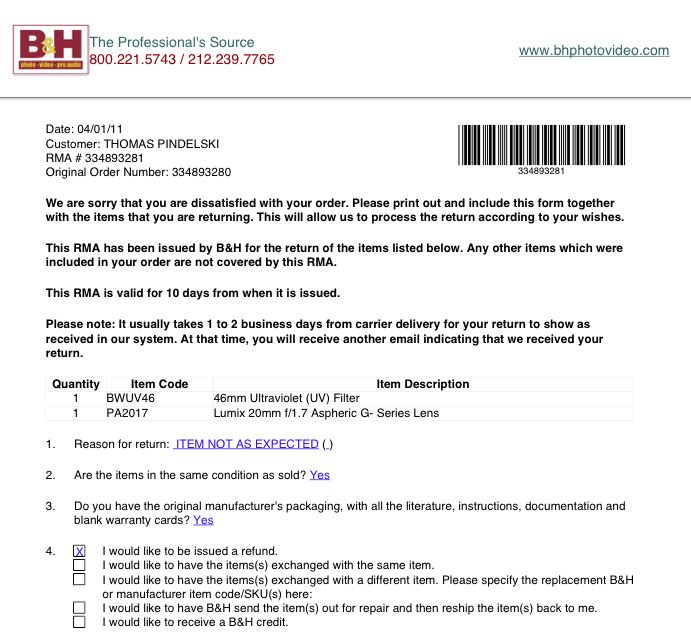
Second return ever to B&H.
Independent ‘reviews’: This piece might as well have been named “Never trust what you read”. It’s unconscionable that not one review of the many I have read focuses on the shortcomings of this lens, especially the critical one of its slow focus. All they go on about is distortion, aberration and vignetting. Charts this, resolving power that.
What, after all, is a pancake, semi-wide’s primary purpose in life? It is to take snapshots.
It’s not for studio portraits.
It’s not for landscapes.
It’s not for cathedral interiors.
It’s for snapshots.
And snapshots mean it has to be fast, not fast as in large aperture but fast as in speed of focus. The modern camera-aware subject does not permit manual focus for the street snapper. It has to be auto everything – focus and exposure. And because the street snapper cannot order up the light, it has to be highly flare resistant because 50% of the time when it’s sunny the sun will be shining into the lens, not on the photographer’s rear end.
In that context, all the reviews I have seen of the Panasonic 20mm lens have been a waste of time to read, written as they are in some laboratory by non-photographers.
